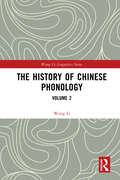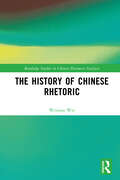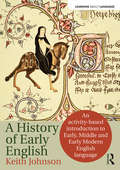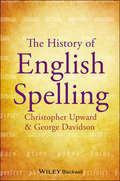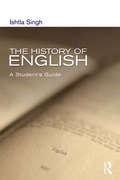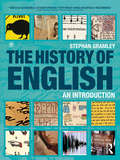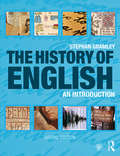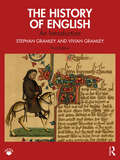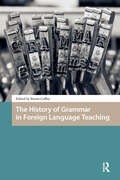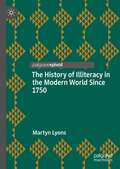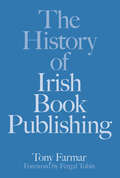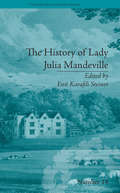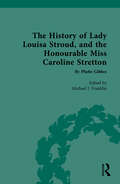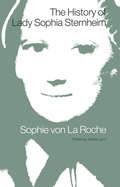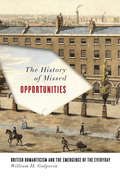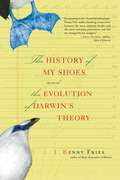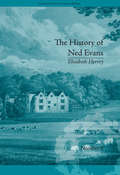- Table View
- List View
The History of Chinese Phonology: Volume 2 (Wang Li Linguistics Series)
by Wang LiAs the second volume of a two-volume set on the history of Chinese phonology, this book studies the history of phonology from the Yuan dynasty until modern times and discusses the four approaches of sound change.Based on abundant phonological materials, the author divides the history of Chinese phonology into nine historical periods, which helps illuminate its evolutions and principles. Following on from the first volume, the first part of this second volume deals with the initials, rhymes, and tones of Chinese phonology from the Yuan dynasty (1279–1368) to modern times (since 1911), illustrating the diachronic sound changes with detailed tables. Based on an historical review of Chinese phonology, the second part of the book classifies sound changes via four major approaches: no change, gradual shift, split, and merger. It then analyzes the natural, conditional, and irregular sound changes, respectively, and the reasons for these changes.This title will be of great value for scholars and students studying Chinese phonology and Chinese linguistics, and readers interested in the essence of rhyming behind Chinese classic lyrics, poetry, drama, and other forms of verse.
The History of Chinese Rhetoric (Routledge Studies in Chinese Discourse Analysis)
by Weixiao WeiThis book challenges the existing misconception that there was no rhetoric in ancient China. Instead, this book provides ample evidence from public speeches in the Xia dynasty and oracle bone inscriptions in the Shang dynasty to public debates about government policies in the Han dynasty to show that persuasive discourse and rudimentary rhetorical techniques already existed in ancient China. Using literary analysis and discourse analysis methods, this book explains how the Mandate of Heaven was inscribed at the core of Chinese rhetoric and has guided Chinese thoughts and expressions for centuries. This book also demonstrates Chinese rhetorical wisdom by extracting many concepts and terms related to language expression, persuasive speech, morality and virtue, life and philosophy, and so on from great Chinese literary works. Well-known names, such as Confucius, Laozi, Sima Qian, Liu Xie, Mozi, Hanfeizi, Guibuzi and so on, are all touched upon with their famous theory and sayings related to and explicated from the rhetorical perspective. Many surprising facts are found by the author and revealed in the book. For example, a thousand years ago, the Chinese author Liu Xie already found that all words have preferred lexical neighbors and structural environment. This is later on ‘discovered’ by corpus linguistics and illustrated, for example, by the concepts of collocation and pattern grammar. This book targets postgraduate students, teachers, researchers and scholars interested in advanced Chinese language and Chinese literature, history, and culture.
The History of Early English: An activity-based approach (Learning about Language)
by Keith JohnsonThe History of Early English provides an accessible and student-friendly introduction to the history of the English language from its beginnings until the end of the Early Modern English period. Taking an activity-based approach, this text ensures that students learn by engaging with the fascinating evolution of this language rather than simply reading about it. The History of Early English: Provides a comprehensive introduction to early, middle and early modern English; Introduces each language period with a text from writers such as Chaucer and Shakespeare, accompanied by a series of guiding questions and commentaries that will engage readers and give them a flavour of the language of the time; Features a range of activities that include discussion points, questions, online tasks and preparatory activities that seamlessly take the reader from one chapter to the next; Is supported by a companion website featuring audio files, further activities and links to online material. Written by an experienced teacher and author, this book is the essential course textbook for any module on the history of English.
The History of Eighteenth-Century Collections Online (Elements in Publishing and Book Culture)
by Stephen H. GreggThis is a history of Eighteenth-Century Collections Online, a database of over 180,000 titles. Published by Gale in 2003 it has had an enormous impact of the study of the eighteenth century. Like many commercial digital archives, ECCO's continuing development obscures its precedents. This Element examines its prehistory as, first, a computer catalogue of eighteenth-century print, and then as a commercial microfilm collection, before moving to the digitisation and development of the interfaces to ECCO, as well as Gale's various partnerships and licensing deals. An essential aspect of this Element is how it explores the socio-cultural and technological debates around the access to old books from the 1930s to the present day: Stephen Gregg demonstrates how these contexts powerfully shape the way ECCO works to this day. The Element's aim is to make us better users and better readers of digital archives.
The History of English Spelling (The Language Library #26)
by George Davidson Christopher UpwardThe History of English Spelling reveals the history of Modern English spelling, tracing its origins and development from Old English up to the present day. Includes a wealth of information and data on English spelling not available anywhere else Features a complementary website with additional material at www.historyofenglishspelling.info Includes detailed coverage of the contributions from French, Latin, Greek - and the many other languages - to our current orthography Serves as a companion volume to Geoffrey Hughes's A History of English Words in the same series
The History of English: A Student's Guide
by Ishtla SinghThe History of English provides an accessible introduction to the changes that English has undergone from its Indo-European beginnings to the present day. The text looks at the major periods in the history of English, and provides for each a socio-historical context, an overview of the relevant major linguistic changes, and also focuses on an area of current research interest, either in sociolinguistics or in literary studies. Exercises and activities that allow the reader to get 'hands-on' with different stages of the language, as well as with the concepts of language change, are also included. By explaining language change with close reference to literary and other textual examples and emphasising the integral link between a language and its society, this text is especially useful for students of literature as well as linguistics.
The History of English: An Introduction
by Stephan GramleyThe History of English: An Introduction provides a chronological analysis of the linguistic, social, and cultural development of the English language from before its establishment in Britain around the year 450 to the present.
The History of English: An Introduction
by Stephan GramleyThe History of English: An Introduction provides a chronological analysis of the linguistic, social, and cultural development of the English language from before its establishment in Britain around the year 450 to the present. Each chapter represents a new stage in the development of the language from Old English through Middle English to Modern Global English, all illustrated with a rich and diverse selection of primary texts showing changes in language resulting from contact, conquest and domination, and the expansion of English around the world. The History of English goes beyond the usual focus on English in the UK and the USA to include the wider global course of the language during and following the Early Modern English period. This perspective therefore also includes a historical review of English in its pidgin and creole varieties and as a native and/or second language in the Caribbean, Africa, Asia, and Australasia. Designed to be user-friendly, The History of English contains: chapter introductions and conclusions to assist study over 80 textual examples demonstrating linguistic change, accompanied by translations and/or glosses where appropriate study questions on the social, cultural and linguistic background of the chapter topics further reading from key texts to extend or deepen the focus nearly 100 supporting figures, tables, and maps to illuminate the text 16-pages of colour plates depicting exemplary texts, relevant artefacts, and examples of language usage, including Germanic runes, the opening page of Beowulf, the New England Primer, and the Treaty of Waitangi. The companion website at www.routledge.com/cw/gramley supports the textbook and features: an extended view of major aspects of language development as well as synopses of material dealt with in a range of chapters in the book further sample texts, including examples from Chaucer, numerous Early Modern English texts from a wide variety of fields, and twenty-first-century novels additional exercises to help users expand their insights and apply background knowledge an interactive timeline of important historical events and developments with linked encyclopaedic entries audio clips providing examples of a wide range of accents The History of English is essential reading for any student of the English language.
The History of English: An Introduction
by Stephan GramleyThe History of English: An Introduction provides a chronological analysis of the linguistic, social, and cultural development of the English language from before its establishment in Britain around the year 450 to the present. Each chapter represents a new stage in the development of the language from Old English through Middle English to Modern Global English, all illustrated with a rich and diverse selection of primary texts showing changes in language resulting from contact, conquest and domination, and the expansion of English around the world. The History of English goes beyond the usual focus on English in the UK and the USA to include the wider global course of the language during and following the Early Modern English period. This perspective therefore also includes a historical review of English in its pidgin and creole varieties and as a native and/or second language in the Caribbean, Africa, Asia, and Australasia. This new edition of The History of English has been thoroughly revised and updated throughout, and features: chapter introductions and conclusions to assist in orientation; over 90 textual examples demonstrating linguistic change accompanied, as necessary, by translations and/or glosses; study questions on the social, cultural, and linguistic background of the periods and topics, as well as recommendations for further reading and topics for further study; over 100 figures, tables and maps to support and illuminate the text; 18 pages of colour plates depicting exemplary texts, relevant artifacts, and examples of language usage, including Germanic runes, the opening page of Beowulf, the New England Primer, and the Treaty of Waitangi; a brand-new companion website hosting further articles on linguistic, historical, and cultural phenomena which go beyond the scope of the book, additional sample texts, exercises, and audio clips. The History of English is essential reading for any student of the English language, and will be of relevance to any course addressing the origins of the English language.
The History of English: An Introduction
by Stephan Gramley Vivian GramleyThe History of English: An Introduction provides a chronological analysis of the linguistic, social, and cultural development of the English language from before its establishment in Britain around the year 450 to the present. Each chapter represents a new stage in the evolution of the language, all illustrated with a rich and diverse selection of primary texts. The book also explores the wider global course of the language, including a historical review of English in its pidgin and creole varieties and as a native and/or second language in the Caribbean, Africa, Asia, and Australasia.The third edition, carefully revised and updated throughout, includes:● chapter introductions and conclusions to assist in orientation plus additional marginal references throughout;● the addition of 21 timelines often running from Old English to Present-Day English and focusing on a variety of features;● a new focus on the relevance of change for and in Present-Day English;● discussions on the role and image of women, the (in-)visibility of social classes, and regional variation in English;● material on bilingualism, code-switching, and borrowing, and on the effects of the social media on language use;● over 90 textual examples demonstrating linguistic change and over 100 figures, tables, and maps, including 31 colour images, to support and illuminate the text;● updated online support material including brief introductions to Old and to Middle English, further articles on linguistic, historical, and cultural phenomena which go beyond the scope of the book, additional sample texts, exercises, and audio clips.With study questions as well as recommendations for further reading and topics for further study, The History of English is essential reading for any student of the English language and will be of relevance to any course addressing the origins and development of the English language.
The History of Girls' Comics
by Susan BrewerSusan Brewer taps into the nostalgic women s market for comics from their childhood Jackie, Girl's Own, Bunty etc, from the early days in Victorian England to teen mags and TV-related comics, including Teletubbies and CBeebies. The book also covers partworks such as the highly collectable Vicky and other collectables, including annuals, covermounts and giveaways and toys and games tie-ins, including board games.
The History of Grammar in Foreign Language Teaching (Languages and Culture in History)
by Simon CoffeyTaking a broadly chronological approach, this volume of original essays traces the origins of the concept of ‘grammar’. In doing so, it charts the social, moral and cultural factors that have shaped the development of grammar from Antiquity, via the Middle Ages, Renaissance and Modern Europe, to current education systems and language learning pedagogy. The chapters examine key turning points in the history of language teaching epistemology, focusing on grammar for language teaching across different European cultural contexts. Bringing together leading scholars of classical and modern languages education, The History of Grammar in Foreign Language Teaching offers the first single-source reference on the evolving concept of grammar across cultural and linguistic borders in Western language education. It therefore represents a valuable resource for teachers, teacher-educators and course designers, as well as students and scholars of historical linguistics, and of second and foreign language education.
The History of Illiteracy in the Modern World Since 1750
by Martyn LyonsThis Palgrave Pivot examines the history of literacy with illiterate and semi-literate people in mind, and questions the clear division between literacy and illiteracy which has often been assumed by social and economic historians. Instead, it turns the spotlight on all those in-between, the millions who had some literacy skills, but for whom reading and writing posed difficulties. Its main focus is on those we have often labelled ‘illiterates’, rather than those who enjoyed full competence in reading and writing in modern society. In offering a historical perspective on the ‘problem’ of illiteracy in the modern world, it also questions some enduring myths surrounding the phenomenon. This book therefore has a revisionist objective: it intends to challenge conventional wisdom about illiteracy.
The History of Irish Book Publishing
by Conor Kostick Tony FarmarThe story of how books in all their variety, from mathematics textbooks to murder mysteries, reach the hands of readers is a significant one. This is especially so in Ireland, where Irish publishing houses battle to flourish and survive through economic crises and in a market dominated by British publishers. The paradox of publishing, writes Tony Farmar, is that though it is a business, and a risky business everywhere, it is much more than that. Publishers’ ‘gatekeeping, encouragement and investing’ help to shape what has been called a country’s ‘mentalities’. Thus the importance of a flourishing local publishing industry, especially those that share a language with an ‘over-mighty neighbour’. The product of many years of research, this book focuses on the years from 1890 and includes a detailed chronicle of the key dates and events in the development of Irish book publishing. The final chapter, by Conor Kostick, covers the period from 2008 to 2018. What emerges is a vivid portrait of how the Irish book publishing industry contributed and continues to contribute in immeasurable ways to the intellectual and cultural life of Ireland.
The History of Lady Julia Mandeville: by Frances Brooke (Chawton House Library: Women's Novels #14)
by Enit Karafili SteinerPublished in 1763, The History of Lady Julia Mandeville was Frances Brooke’s first and most successful novel. This modern critical edition contains an introductory essay on the text, endnotes and textual variants as well as appendices containing contemporary reviews and some of Brooke’s other writing.
The History of Lady Louisa Stroud, and the Honourable Miss Caroline Stretton: by Phebe Gibbes (Chawton House Library: Women's Novels)
by Michael J. FranklinThis new edition of the British epistolary novel The History of Lady Louisa Stroud, and the Honourable Miss Caroline Stretton examines the theme of female agency, and is an excellent example of women's writing in the eighteenth-century. The relationships of the author, Phebe Gibbes, with the East India Company, The London Magazine, ‘The Benevolent Society’, and the Royal Literary Society provide rich avenues for research. Accompanied by a new introduction and editorial commentary, this text will be of great interest to students of literary history and women's writing.
The History of Lady Sophia Sternheim (Pickering Women's Classics)
by J CollyerThe best-known novel of Sophie von La Roche, a German 18th-century woman writer. The plot reflects typical 18th-century concerns: the value of sentiment and the importance of virtue in attaining a good life. The publication of this novel reflects a recent revival of interest in the author.
The History of Language Teaching from The Spanish-American War Until the Sputnik Moment: From Hot to Cold Wars
by H. Jay SiskinThis book highlights the lively exchanges that shaped foreign-language pedagogy and educational policy during the first fifty years of the twentieth century. It is critically important to revivify our past, particularly in a field where innovation is conceptualized as progress and where knowledge production is a criterion for success. Modern language teaching began its ascendancy shortly before the turn of the twentieth century. In the academy, this impulse was marked by the founding of the Modern Language Association in 1883. Modern languages were increasingly recognized as possessing the mental and humanistic values that had formerly been the sole province of Greek and Latin. The book provides an overview of the historical, political, and social concerns that preoccupied the nation from 1898 and provides a context for analyzing the developments in the teaching of foreign languages over the course of the following century.
The History of Languages: An Introduction
by Tore JansonThis is an introduction to the history of languages, from the distant past to a glimpse at what languages may be like in the distant future. It looks at how languages arise, change, and ultimately vanish, and what lies behind their different destinies. What happens to languages, he argues, has to do with what happens to the people who use them, and what happens to people, individually and collectively, is affected by the languages they speak. <p><p>The book opens by examining what languages the hunter-gatherers might have spoken and the changes to language that took place when agriculture made settled communities possible. It then looks at the effects of the invention of writing, the formation of empires, the spread of religions, and the recent dominance of world powers, and shows how these relate to great changes in the use of languages. Tore Janson discusses the appearance of new languages, the reasons why some languages spread and others die, considers whether similar cyclical processes are found at different times and places, and examines the causes of internal changes in languages and dialects. The book ranges widely among the world's languages and mixes thematic chapters on general processes of change with accounts of specific languages, including Chinese, Arabic, Latin, Greek, and English.
The History of Late Modern Englishes: An Activity-based Approach (Learning about Language)
by Keith JohnsonThe History of Late Modern Englishes provides an accessible and student-friendly introduction to the history of the English language from the beginning of the eighteenth century up until the present day. Taking an activity-based approach, this text ensures that students learn by engaging with the fascinating evolution of this language rather than by simply reading about it. The History of Late Modern Englishes: • Covers the development of Englishes around the world, not only in the British Isles, but also in the United States, Canada, India, Singapore, Australia, New Zealand, and Melanesia, as well as in other countries around the world where English is used as a lingua franca; • Accommodates the needs of both native and non-native speakers of English, with helpful features such as a glossary of key terms and questions to guide the reader through the book; • Includes activity sections and discussion points to help students engage with the text; • Is accompanied by e-resources which include further activities and additional coverage of points of interest in the book. Written by an experienced teacher and author, this book is an essential course textbook for any module on the history of English and the perfect accompaniment to the author’s own The History of Early English.
The History of Missed Opportunities: British Romanticism and the Emergence of the Everyday
by William GalperinThrough close engagement with the work of Wordsworth, Austen, and Byron, The History of Missed Opportunities posits that the everyday first emerged as a distinct category of experience, or first became thinkable, in the Romantic period. Conceived here as something overlooked and only noticed in retrospect, the everyday not only becomes subject matter for Romanticism, it also structures Romantic poetry, prose, and writing habits. Because the everyday is not noticed the first time around, it comes to be thought of as a missed opportunity, a possible world that was not experienced or taken advantage of and of whose history—or lack thereof—writers become acutely conscious. Consciousness of the everyday also entails a new relationship to time, as the Romantics turn to the history of what might have been. In recounting Romanticism's interest in making things recurrently present, in recovering a past of what was close at hand yet underappreciated, William H. Galperin positions the Romantics as precursors to twentieth-century thinkers of the everyday, including Heidegger, Benjamin, Lefebvre, and Cavell. He attends to Romantic discourse that works at cross purposes with standard accounts of both Romanticism and Romantic subjectivity. Instead of individualizing or turning inward, the Romantics' own discourse depersonalizes or exhibits a confrontation with thing-ness and the material world.
The History of My Shoes and the Evolution of Darwin's Theory
by Kenny Fries<p>In The History of My Shoes, Kenny Fries narrates two stories: the development of the theory of "survival of the fittest," as articulated by Charles Darwin and Alfred Russel Wallace; and the history of his ever-changing, made-to-order, orthopedic shoes. <p>The famously important first story, as told by Kenny Fries, is a condensed and colorful account of the race between Darwin and Wallace to formulate their groundbreaking theories. <p>At the same time, Fries, a gay and disabled man, tells a deeply personal story of the evolving consciousness of his own "adaptations," represented by his shoes. As a child, Fries was abused by both his father and brother, and emerged into adulthood swaddled in ambiguities of self and memory. <p>These he has explored in his brutally frank memoir, Body, Remember. In this poetic, introspective book, Kenny Fries imaginatively illustrates how his identities intersect. He writes, "Much of my own work the past fifteen years has been concerned with the body, as both subject and metaphor; as the place where the personal becomes the universal; as the site of memory, language, and desire." <P>Although only the "fittest" may survive, Fries learns that adaptation and variation are critical to survival. What is deemed normal, or even perfect, are passing phases of the ever-changing embodiment of nature in our world. In the end, Darwin and Wallace's discoveries resonate with Fries's own story in The History of My Shoes.
The History of Ned Evans: by Elizabeth Hervey (Chawton House Library: Women's Novels)
by Helena KellyNed Evans is a rags-to-riches hero, whose early existence in poverty in Wales is dramatically changed when he saves the beautiful Lady Cecilia Rivers from an assault and is invited to Ireland by her father. After spending time with the great and the good of Irish society, Ned travels to America where his fortunes once more reverse.
The History of Pompey the Little: Or The Life and Adventures of a Lap-Dog (Routledge Revivals)
by Francis CoventryOriginally published in 1974, this volume of The History of Pompey the Little includes a critical introduction and a biographical sketch of the author based on new material from unpublished documents, together with explanatory notes for the novel's many classical and contemporary allusions. Francis Coventry's The History of Pompey the Little was the talk of London in 1751; it continued to captivate readers throughout the century. Satirizing notable persons and events of its day, it startled the public by having as its 'hero' a Bologna lapdog, and created a new and popular form in English fiction - the 'spy'-novel with a non-human observer.
The History of Reading, Volume 1: International Perspectives, c. 1500–1990
by Shafquat Towheed W. R. OwensThe History of Reading, Volume 1: International Perspectives, c. 1500–1990 by Shafquat Towheed and W. R. Owens.
